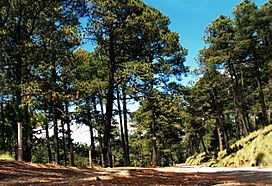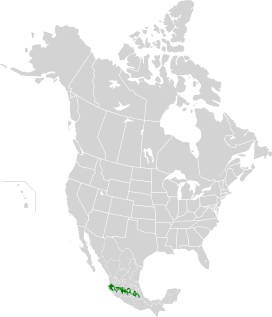Trans-Mexican Volcanic Belt pine–oak forests facts for kids
Quick facts for kids Trans-Mexican Volcanic Belt pine–oak forests |
|
|---|---|

Popocatépetl, Puebla state
|
|

Location of the ecoregion
|
|
| Ecology | |
| Realm | Neotropical |
| Biome | Tropical and subtropical coniferous forests |
| Borders |
List
|
| Geography | |
| Area | 92,503 km2 (35,716 sq mi) |
| Country | Mexico |
| States | |
| Conservation | |
| Conservation status | Critical/endangered |
| Protected | 17.85% |
The Trans-Mexican Volcanic Belt pine–oak forests are a special type of forest found in central Mexico. This area is known as an ecoregion, which is a large area of land or water that contains a distinct set of natural communities and species. Here, you'll find many coniferous trees like pines and firs, mixed with oak trees. These forests are part of the Trans-Mexican Volcanic Belt, a chain of volcanoes that stretches across Mexico.
Contents
Where are these Forests?

These unique forests cover a huge area of about 92,503 square kilometers (about 35,716 square miles). They stretch all the way from the state of Jalisco in the west to Veracruz in the east.
The main part of this volcanic belt goes through several Mexican states. These include Jalisco, Michoacán, México, Morelos, Tlaxcala, Puebla, and Veracruz. The ecoregion also includes smaller mountain ranges. You can find these in Guanajuato, like the Sierra de Santa Rosa, Sierra de Lobos, and Sierra de Pénjamo. It even reaches north to El Gogorrón National Park in San Luis Potosí.
These pine–oak forests are surrounded by other types of natural areas. To the west, northwest, and south, you'll find tropical dry forests. These include the Jalisco dry forests, the Balsas dry forests, and the Bajío dry forests. To the north, there's the Central Mexican matorral, which is a type of shrubland. The Tehuacán Valley matorral is in a dry valley to the southeast. To the east, the wetter Veracruz montane forests and Oaxacan montane forests connect these pine–oak forests to the tropical forests near the Gulf of Mexico.
Sometimes, you'll find small patches of mountain grasslands and shrublands mixed within the pine–oak forests. These special areas are called Zacatonal.
Amazing Plants of the Forests
The forests are home to different groups of plants. You'll mostly see pine forests, pine–oak forests, oak forests, pine–cedar forests, and pine–fir forests. The types of plants you find change depending on how high up you are and how much rain the area gets.
- Pine forests usually grow between 2,275 and 2,600 meters (about 7,464 to 8,530 feet) high.
- Pine–oak forests are found a bit higher, between 2,470 and 2,600 meters (about 8,104 to 8,530 feet).
- Pine–cedar forests grow above 2,700 meters (about 8,858 feet).
- Pine–fir forests are found even higher, above 3,000 meters (about 9,843 feet).
In the pine forests, you'll often see the Montezuma pine (Pinus montezumae). In wetter spots, the smooth-bark Mexican pine (P. pseudostrobus) is common. In dry areas with thin soil, you might find Hartweg's pine (P. hartwegii) and P. tecote.
The pine–fir forests are mostly made up of Hartweg's pine (Pinus hartwegii) and the sacred fir (Abies religiosa).
The western part of this ecoregion, in Jalisco and Colima states, has many plant species found nowhere else. For example, Quercus iltisii is a type of oak tree found only in the mountains of Jalisco and Colima. Quercus cualensis is another oak, known only from the Sierra el Cuale in western Jalisco, and it's endangered. Magnolia iltisiana is a beautiful magnolia tree found in the Manantlán and Cacoma sierras. Also, Pinus jaliscana is a pine tree found only in western Jalisco.
Cool Animals of the Forests
This ecoregion is a home for many interesting animals, especially birds and mammals.
Some birds are almost only found here, like the Transvolcanic jay (Aphelocoma ultramarina), the Sierra Madre sparrow (Xenospiza baileyi), and the green-striped brushfinch (Atlapetes virenticeps). Other native birds you might see include the great horned owl (Bubo virginianus), the long-tailed wood partridge (Dendrortyx macroura), and the Montezuma quail (Cyrtonyx montezumae).
Two mammals are found only in this ecoregion: the volcano rabbit (Romerolagus diazi) and the Mexican volcano mouse (Neotomodon alstoni). This means they are endemic to this special forest area.
Monarch Butterflies: A Winter Home
One of the most amazing things about these forests is that they are the winter home for millions of monarch butterflies (Danaus plexippus). These butterflies travel thousands of miles from colder parts of North America, east of the Rocky Mountains, to spend the winter here. They gather in huge numbers on the trees in the pine–oak forests of eastern Michoacán and western México states. The Mariposa Monarca Biosphere Reserve is a special protected area within this forest that helps keep these butterflies safe.
Protected Areas: Keeping the Forests Safe
A good portion of this ecoregion, about 17.85%, is protected. This means these areas are set aside to keep the plants and animals safe and healthy. Some of these important protected areas include:
- Barranca del Cupatitzio National Park
- Bosencheve National Park
- Chichinautzin Biological Corridor
- Cofre de Perote National Park
- Cumbres del Ajusco National Park
- Desierto de los Leones National Park
- Iztaccíhuatl–Popocatépetl National Park
- Lagunas de Zempoala National Park
- La Malinche National Park
- Monarch Butterfly Biosphere Reserve
- Nevado de Toluca Flora and Fauna Protection Area
- Pico de Orizaba National Park
- La Primavera Biosphere Reserve
- Sierra de Manantlán Biosphere Reserve
- El Tepozteco National Park
- Volcán Nevado de Colima National Park
Images for kids
-
Popocatépetl, Puebla state
See also
 In Spanish: Bosques de pino-encino del Eje Neovolcánico Mexicano para niños
In Spanish: Bosques de pino-encino del Eje Neovolcánico Mexicano para niños
- Pine-oak Forests of Puebla, Mexico
- Conifers of Mexico
- List of ecoregions in Mexico



